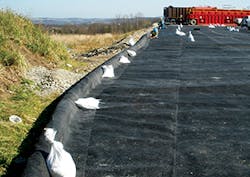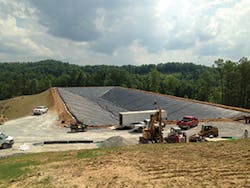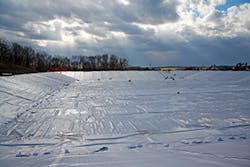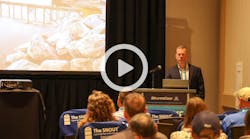Managing Erosion in the Oil and Gas Industry
Editor’s note: This article first appeared in the September-October 2015 edition of Erosion Control.
The evolution of the oil and gas drilling industry in the US has all the essential components of a blockbuster adventure novel—colorful characters, challenging landscapes, spectacular discoveries, deals and dollars, and a lot of each of them. For many of us, our only exposure to what drilling is all about comes from that source of dubious but entertaining historical resource—the movies. Hellfighters, Giant, Boom Town, and others depicted real rigs and the rigorous hallmark grit, grime, and greed that helped to both launch the US to world power and became the heartache of conservationists. Not for decades would the term “environment” enter the script.
But as with any industry that has undergone significant evolution, today’s drillers have the benefit of sophisticated technologies that allow (perhaps arguably) the best of both worlds—extracting oil and gas while maintaining the landscape and leaving the site “better than you found it.” That means ensuring local watersheds are not contaminated with pollutants and sediment from erosion and from the huge amounts of water that are now required for modern practices.
Untrapping the Natural Wealth
Today, the hotbed of activity in new gas and oil drilling is primarily within the Marcellus Shale region that stretches from eastern Ohio across West Virginia and Pennsylvania, and terminates in upstate New York near the Finger Lakes.
Shale is an organic-rich rock that was formed in an oxygen-deficient marine environment nearly 400 million years ago. As the organic material slowly decomposed—making oil—it formed gases that remained trapped within the rock formations. This region, covering about 54,000 square miles, is now the largest natural gas area in the country.
The layers of shale range in thickness from less than 10 feet in the Ohio and western Pennsylvania Lake Erie shoreline regions, to more than 250 feet in northern Pennsylvania. However, the depth (distance from front to back) ranges from 0 to 9,000 feet.
According to the US Energy Information Administration, in 2015, nearly five million barrels of crude oil were produced from shale oil sources, and the Marcellus region, in particular, outperforms all other gas-producing regions by several magnitudes, with more than 11,000 cubic feet of gas produced per day for new rig drilling. With recent brutal winters, that’s good news for the home heating market.
However, as an interesting side note, although natural gas was known to be trapped in the shale layers, it was originally considered a nuisance to oil drillers because there was little use for the product.
A Resource to Launch US Wealth
Rock oil, as it’s called when derived from shale, was first found in Titusville, PA, and was originally used as a source of lighting oil that was patented as “kerosene.” The first-ever drilling operation in 1859 was organized by Colonel Edwin Drake, who hired expert salt driller William A. Smith (who literally knew the drill), and the Titusville oil wells made history. These were the springboard to drill more wells, which launched the industry that led to huge profits by investors and entrepreneurs such as the Rockefellers, Stephen V. Harkness, and Henry Flagler, the founder of the Standard Oil Company.
But by the beginning of the new century, Texas challenged Pennsylvania as the kingpin of oil production with a huge discovery that personified the term “gusher.” On January 10, 1901, drillers in east Texas near Beaumont drilled on a salt dome called Spindletop. After reaching down more than a 1,000 feet they literally ran for their lives. A fountain of fast-moving mud was followed by oil that flew 150 feet in the air. The site was soon proclaimed the most powerful gusher in the world, producing 100,000 barrels of oil every day.
In both cases, the local economies of Pennsylvania and Texas were transformed practically overnight. While the Texas discovery broke the oil monopoly of the northeastern oil giants, the finds in both regions led to tremendous growth in transportation, and to chemical and medical discoveries from the growing petrochemical industry. They created wealth that supported education, local communities, and civic and social needs. Not a lot of thought was given to environmental impact, carbon footprint, or erosion.
But with today’s conventional drilling—and particularly the horizontal drilling in the Marcellus Shale region and elsewhere—environmental issues are front and center. Huge amounts of water are required, and this often must be trucked in, requiring the building of roadbeds, water collection and disposal, and management of erosion and sediment.
Managing Millions of Gallons
“What has made the US oil and gas reserve the greatest in the world is our ability to use unconventional drilling and hydofracturing,” explains Rod Kirch of GSE Environmental Inc. This international company is the world’s largest manufacturer of geosynthetics used for the environmental containment and protection.
“Our products are typically used as the lining system for the ponds where the water from oil and gas mining is collected,” he says. He describes how water is an essential component of the industry, but getting it to the site, as well as collecting and managing it during and after its use, poses challenges to ensure the environment is not affected.
“We use horizontal drilling in Pennsylvania and elsewhere in the US,” he says. “This is where you go straight down 6,000 to 8,000 feet, change equipment to a directional rig, slowly make a turn horizontally, and continue to drill for up to a mile into layers of shale rock where the oils and gas were made.”
Since the first conventional Titusville wells were drilled in the mid-1800s, little has changed in the drilling process, but Kirch says that the combination of harder-to-reach oil and higher prices for crude oil put these older wells on the decline as horizontal wells—which are more profitable—are on the rise.
In Pennsylvania alone, conventional wells have declined considerably from a high of 4,836 in 2007, to fewer than 1,000 drilled in 2013, while horizontal gas drilling has been increasing exponentially.
“However, you can’t access the resources—oil or gas—without using the fracturing method,” says Kirch. This involves using a charge to initially fracture the rock. “Then you force water, sand, and chemicals down the well and into the pre-fractured area.
This process then forces the initially small cracks open further and holds them open, allowing oil and gas to flow up and out of the well. But doing so requires millions of gallons of water.”
After the water is pumped in, much of it comes back up to the surface, eventually.
“In Pennsylvania, the local rock absorbs much of the water, up to 60 to 70% of it, while in Texas, 70 to 90% of the water pumped into the well comes back to the surface—and when it does, you have to have a place to store it, treat it, and eventually dispose of it.”
The water brings up other materials as well. The shale beds, Kirch explains, were “the bottom of the ocean at one time,” so a lot of salt, as well as the chemicals that were pumped down the well during drilling, come back up with the water.
“In the early days of Marcellus exploration and production, people used to take this water to the local POTW [publicly owned (wastewater) treatment works], but then bromine started showing up in the rivers, so that was stopped,” he says. “Today, most of this water is captured, stored, treated, and reused for future hydrofracturing projects. Excess waters are disposed of in accordance with state and federal regulations, including deep-well injection or via evaporation in the arid west.”
He adds that as the industry has matured, so too have technologies and self-policing, which has made their processes safer and more environmentally sound.
Liner installation
Lining It All Up for Later
Kirch says the GSE polyethylene liner containment system allows industry “to reuse as much water as we can,” while at the same time, maintaining controls over leakage and overflow escape water that contributes to erosion.
With 30 years of experience engineering liner and containment systems for landfills, he says, “We took all that we learned from that arena and adapted it for gas and oil.”
He adds, “We’ve developed an impoundment containment system for the flowback waters that come back up the well that is virtually leakproof. These impoundments have to be leakproof; you don’t want to pollute, because if you create a legacy problem you have to deal with serious, long-lasting risks to human health and the environment, not to mention the negative public imagine that hits one’s stock price and ability to get the next lease. In Texas, most of the work is done in pretty sparsely populated areas, but this is not the case in Pennsylvania, Ohio, and the rest of the northeast where in some cases you are working just hundreds of yards from an Amish farmer’s front door. We are very mindful of our responsibilities.”
Kirch says the produced water impoundments are designed and built with multiple, redundant layers of liner including compacted natural clay; a nonwoven geotextile for cushioning and liner protection; a geosynthetic clay liner (GCL); and a two-layer (primary and secondary or backup) UV-resistant, high-density polyethylene (HDPE) liner. At least the primary liner (the one touching the contaminated water) has an integral leak location system.
He explains how the components work together. First, the ground is prepared by roll-compacting, low-permeability native soils or imported clay, which acts as the subgrade. The next layer is the GCL, “which contains high-swell, Wyoming-grade sodium bentonite, a natural product that holds several times its own weight in water,” says Kirch. “If a hole forms, the bentonite swells into the void and this self-repairing clay layer will close up on that hole, preventing water leak.”
He adds, “Typically in these applications, this layer may also contain a special polymer enhancement if the waters to be contained in the impoundment have high salinity, high calcium content, or certain other constituents.”
The next layer is the HDPE liner, which is a minimum of 40 mils thick; in some cases a 60-mil liner is used. Kirch says this secondary liner can be upgraded to GSE’s patented leak location conductive liner, which extends down into a sump area for removal of leaked liquid. This liner is capable of transmitting an electrical charge that pinpoints leaks both immediately after installation and prior to the containment system being put into service, and again once the system is full and operational.
Next is geonet, or geocomposite drainage net, a minimum of 200 mils thick, which acts as a leak detection layer. This drainage net, “which acts like a horizontal drain,” covers the sides and bottom of the pond and extends down into the sump formed by the secondary HDPE liner to convey and hold for removal any liquids that pass through the primary liner.
The final layer, the exposed top layer, is called the primary liner; it is also an HDPE liner with a minimum thickness of 60 mils. In many cases, the leak location and conductive liner is used for this layer as well.
Kirch notes that the impoundment floor is sloped so that any leaking water will fall to one corner and can be removed by submersible sump pumps. But he cautions that there is crucial preliminary testing to ensure the liners remain leakproof after they are installed.
“Clearly, when you are working with a four- to six-acre belowground impoundment, you need to know before you finish that the liners are leakproof—not afterward,” says Kirch. He adds that a technician will sweep the primary and secondary plastic liners with equipment that can electrically detect the smallest pinholes, which are then marked for repair. Once a third-party construction quality inspector signs off on the liner, the contractor can complete the project and the impoundment can be put into service.
“In some areas of the country, when you inject a million gallons of water into a well during the completion operation, you can expect about 600,000 gallons of it to come back up to the surface. The first 20% comes up in the first few weeks of operation, and the balance comes back over time, and it needs to be properly managed and stored—piped to an impoundment and properly contained.”
Unlike the practice of several years ago, the saline waters recovered today can be reused. Hydrofracturing technology has evolved, and saline content is no longer such an issue as it once was.
“Water is the key to the hydrofracking business, and we use it economically; we’ve learned how to adapt to using dirtier water. We’re constantly finding new means to allow an efficient reuse of water. These containment systems that protect the environment from erosion and harm are an ideal solution toward that economy.”
The impoundment has multiple, redundant layers of liner.
Green Engineering as a Primary Initiative
“We’re not a product, but a holistic solution,” says Adam Dibble, CESSWI, senior marketing and erosion control brand manager with Profile Products. He says the company is founded on a mission to help clients control erosion and manage sediment and plant establishment across a range of industries and terrains, with a focus on sustainability and environmental reclamation.
“We are only going to bring a product to market if it meets these multiple requirements: It has to have no negative environmental impact, be phytosanitized, be wildlife friendly and biodegradable, and pass EPA toxicity testing, meaning that it is 100% benign to humans, terrestrials, and wildlife.”
He describes how the company helps oil- and gas-drilling clients return the landscape to its original state. “The drill and pipeline installation area gets stripped, since they have to scrape off the surface and run pipes; after the pad is poured they put all that material back in on top of the pipes, grade it level, and then get the area revegetated. This is where we come in with either Flexterra or ProMatrix—each an engineered fiber matrix,” he explains. The two products are “extremely effective and were developed under green design engineering,” he notes.
“We knew when we developed products for the mining industry that there are very sensitive environmental concerns. You have to restore the landscape, but this is not about just throwing down some mulch and seed and getting grass to grow; it’s a sophisticated, customized process. Often these sites are so remote the hydroseeding contractors do not have the ability to access them again, so getting the right protection to ensure erosion and vegetation establishment is critical the very first time.”
What’s in That Dirt?
One of the first steps is to analyze the soil. Dibble says that a soil test is performed by a third-party, certified laboratory and is essential—in fact, so important that Profile Products actually pays for the testing to help ensure this step is not overlooked.
“Treating the land without a soil test is like going to the doctor and getting a diagnosis without an evaluation—we call that malpractice!”
With the results of the soil analysis and the proprietary Profile Solution software, he says, “We can tell you your soil pH, where it is deficient in micro- or macronutrients, whether you need fertilizer, and what percent organic matter. In addition to treating the soil, we look at what type of erosion control you need to support the new growth. We look at all aspects to be considered—the climate, the rainfall, land slope, species of vegetation desired, and timing of installation.”
He continues, “Once we know all the relevant factors and the specific needs of the soil, we create the right project approach by making recommendations for products, loading, mixing, and installing.”
Key ingredients in the engineered matrix of Flexterra and ProMatrix are thermally refined wood fibers. Both products are composed of recycled wood fibers, which, when mixed with the other constituents, have a high water retention capacity after being applied.
“The wood fibers are derived from pre-consumer wood waste that we buy and process. This includes clean, post-production wood and wood chips from the furniture manufacturing industry, spoils, the ends of wood boards—we harvest all these and recycle them for our use using a patented process that uses steam to phytosanitize and breakdown the chips. The process eliminates the chance of introducing unwanted terrestrials, noxious wildflowers, and other potentially invasive and non-native species.”
He notes, “In the old days, when people threw straw on top of new seeds, it didn’t offer any moisture retention or protection from dry weather, and it offered virtually no erosion protection. Water just ran underneath the straw and washed seeds away, creating gullies and eroding soil. ProMatrix and Flexterra hold 1,200% and 1,700% of their weight in water, giving them exceptional climactic and weather resistance.”
The application also includes seed to replace the native plants, which Dibble says are sourced from specialty seed providers. In some cases, the state department of transportation specifies what kind of seeds must be used.
The constituents are shipped from a local distributor to the drilling or pipeline construction area, where they are mixed onsite and then applied, often with turret-mounted hydroseeding equipment.
“Typically, 50 pounds of Flexterra is mixed with 125 gallons of water, so with a standard 3,000-gallon tank you can get a third- to half-acre in coverage,” he says.
When needed, Dibble says, the product can also be loaded onto a helicopter and aerially in locations that are either very large or are inaccessible by ground vehicles.
Terry Gwinnup, founder of Gwinnup’s Restoration and Environmental Services, says the Milroy, IN, company “is the ultimate provider of restoration and environmental services,” with more than two decades experience in seeding and landscape restoration. He says he was highly motivated to use his landscaping experience to develop techniques suited to the specific demands of the drilling and pipeline industry.
“I did our first pipeline in 2008, and around 2011, I began using Flexterra and was so impressed with the performance I have been using Profile exclusively ever since.” The company has done more than 400 miles of pipeline restoration.
“I can say that our 98% success rate for these pipeline restorations—which can be very complex operations—is due directly to the capabilities of Flexterra and ProMatrix.”
As an example he cites a 20-mile gas pipeline restoration that showed germination in 10 days; in another 10 days, he says, “they already had good coverage of the surface.”
He also cites the recent flooding tragedy of June 2016 in West Virginia, where a once-in-a-1,000-year rainfall (8–10 inches in six hours) resulted in staggering devastation. However, the West Virginia pipeline restoration that Gwinnup had recently completed remained intact, which he credits to the exceptional water-retaining property of Profile’s engineered fiber matrix.
Mining Engineer Applauds the CWA
“I’ve been working to keep water clean since the Clean Water Act was passed in the 1970s,” says Bob Hanson of Boise, ID, founder and developer of Gator Guard Environmental Products Inc. “After working in excavation for most of my career as a mining engineer, I retired from that industry and began focusing on creating products for the construction market.”
But this was not a new endeavor, he explains. Hanson had learned firsthand the tough challenges facing these industries and was committed to exploring new options that would protect and preserve the environment.
“After much trial and error, we came up with a tough and effective sediment control wattle that catches runoff, allowing sediment to drop out and water to flow through the geotetile outer shell,” he explains.
“A similar product, Gator Guard foam logs, are used as driveable berms around the perimeter of drill pad liners, which several states now require, to contain dirty water and spills from fracking operations. Typically, these drill pads are covered by 2,500 square feet of impermeable liner, so if anything spills or collects on the liner it will be contained, treated, and then reused or released.”
Gator Guard foam logs are available in Standard and Extreme versions in 25-foot lengths with either 6- or 9-inch diameters, and are filled with a “closed-cell polyethylene foam, which does not soak up water.”
Hanson explains that the “standard” foam material is derived from recycled pieces of scrap foam, “like the type you would find from the fabrication of padding used for shipping computers or other equipment.”
The extreme version is fabricated in the Idaho factory from 1-inch-thick sheets, and then slit, rolled up, and placed into a geotextile sleeve that has an apron extension, allowing it to be nailed into the soil. Installation doesn’t require any special tools or expertise.
“The wattle can either be nailed on the soil surface, with 1-inch backfill of soil on top of the apron—which holds it in place and minimizes underflow washout—or installed in a 3-inch dug trench. We’re extremely confident about the product resilience and its ability to prevent erosion,” adds Hanson.
Proving Erosion Prevention
San Diego State University tested the sediment capturing capacity of Gator Guard wattles, comparing them against straw wattles or no treatment through a simulated rainfall on a 3H:1V compacted dirt slope, and measuring the amount of soil lost.
In the 80-minute simulation, the products were subjected to an artificial rainfall, beginning with 2 inches an hour for 20 minutes, increasing to 4 inches an hour for 30 minutes, and then 6 inches an hour for 30 minutes.
“In their test, Gator Guard was the clear winner in what would be considered a 10-year rainfall event for the Los Angeles Basin—just the first 18 minutes of the test,” says Hanson. In other words, in the simulated torrential rainfall, “They found our wattles prevented soil loss with 98% effectiveness with only a two-pound soil loss. On the other hand, the straw wattles were only 55% effective and had a 44-pound soil loss, and with no treatment there was a loss of 100 pounds.”
When Gator Guard is used around drilling operations, the downstream splash apron prevents erosion from below. A sleeve at the end of each wattle fits over the adjacent wattle so they are attached end-to-end.
“You can cut them to any length and run them in an uninterrupted barrier as far as you need, or shape them in whatever configuration you want. When you’re laying pipeline, you can pick them up and just keep them moving down the line.”
“Our Extreme wattle can hold up to heavy equipment tires and tracks, and can retain almost its full height after being driven over repeatedly,” he says.
The Standard model, which is made with fist-sized foam pieces, can take a lot of abuse as well, and might take on a slightly flattened egg shape, but Hanson notes, “You can easily re-form it back into its original shape.”
What Lies Ahead
The dramatic increase in domestic oil and gas production has benefitted the economy and decreased our dependence on foreign sources. Yet the industry has also spurred the companies that create products to protect the environment. Awareness by citizens, regulators, and the industry itself has greatly increased. Happily, the footprint we leave today is dramatically different from what it once was. Companies are committed to continue the necessary research to develop protective measures and innovative technologies that reduce environmental impacts.




